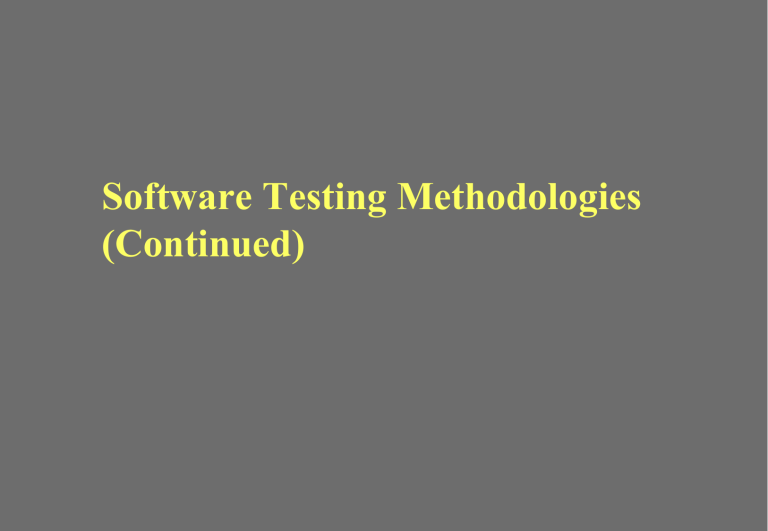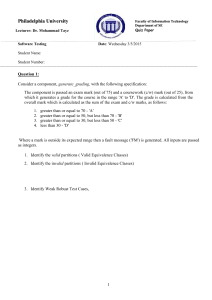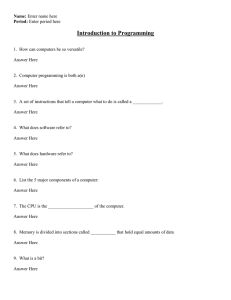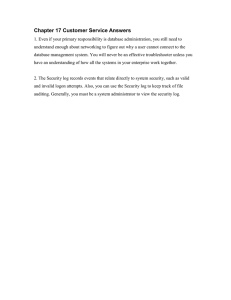
Software Testing Methodologies (Continued) What is a Testing Technique? A procedure for selecting or designing tests based on a structural or functional model of the software. It is successful at finding faults. It is considered a 'best' practice. It is a way of deriving good test cases. It is a way of objectively measuring a test effort. Testing should be rigorous, thorough and systematic. Advantages of Testing Techniques Different people - similar probability of finding faults - Gain independence of thought Effective testing - find more faults - Focus attention on specific types of fault - Know that you are testing the right thing Efficient testing - find faults with less effort - Avoid duplication - Use systematic techniques that are measurable Using techniques makes testing much more effective Why Dynamic Test Techniques? Exhaustive testing (use of all possible inputs and conditions) is impractical - Must use a subset of all possible test cases - Must have high probability of detecting faults Need thought processes that help us select test cases more intelligently - Test case design techniques are such thought processes Measurement Objective assessment of thoroughness of testing (with respect to use of each technique) - Useful for comparison of one test effort to another For example, Project A 60% Equivalence partitions 50% Boundaries 75% Branches Project B 40% Equivalence partitions 45% Boundaries 60% Branches Types of Systematic Technique Static (Non-Execution) • Examination of documentation, source code listings, and so on. Functional (Black Box) • Based on behaviour/ functionality of software Structural (White Box) • Based on structure of software Test Techniques Dynamic Static etc. Reviews Inspection Walkthroughs Structural Desk-checking Symbolic Execution Non-functional Functional etc. etc. Control Flow Data Flow etc. Behavioural Static Analysis Performance etc. Statement Branch/Decision Definition -Use Branch Condition Equivalence Partitioning Usability Arcs LCSAJ Branch Condition Combination Boundary Value Analysis Cause-Effect Graphing Random State Transition Black Box versus White Box? Black Box testing is appropriate at all levels, but dominates higher levels of testing. Acceptance System White Box testing is used predominately at lower levels to compliment Black Box testing. Integration Component Black Box Test Design and Measurement Techniques Techniques defined in software component testing standard BS 7925-2 are as follows: - Equivalence Partitioning (EP) - Boundary Value Analysis (BVA) - Decision table testing - State transition testing Equivalence Partitioning - Divides (partition) the inputs, outputs, and so on, into areas that are the same (equivalent) - Assumption - if one value works, all will work - One value from each partition better than all from one invalid valid 0 1 100 invalid 101 Boundary Value Analysis - faults tend to lurk near boundaries - good place to look for faults - test values on both sides of boundaries invalid valid 0 1 invalid 100 101 Example - Loan Application Customer Name Account number Loan amount requested Term of loan Monthly repayment 2-64 chars. 6 digits, 1st non-zero £500 to £9000 1 to 30 years Term: Repayment: Interest rate: Total paid back: Minimum £10 Customer Name Number of characters: invalid Valid characters: Conditions Customer name Valid Partitions 2 to 64 chars valid chars 1 2 valid A-Z -’ a-z space Invalid Partitions < 2 chars > 64 chars invalid chars 64 65 invalid Any other Valid Boundaries 2 chars 64 chars Invalid Boundaries 1 chars 65 chars 0 chars Account Number first character: valid: non-zero invalid: zero number of digits: invalid Conditions Account number Valid Partitions 6 digits 1st non-zero Invalid Partitions < 6 digits > 6 digits 1st digit = 0 non-digit 5 6 7 valid Valid Boundaries 100000 999999 invalid Invalid Boundaries 5 digits 7 digits 0 digits Loan Amount 499 invalid Conditions Loan amount Valid Partitions 500 - 9000 500 9000 valid Invalid Partitions < 500 >9000 0 non-numeric null 9001 invalid Valid Boundaries 500 9000 Invalid Boundaries 499 9001 Condition Template Conditions Valid Partitions Customer 2 - 64 chars valid chars name Account number 6 digits 1st non-zero Loan amount 500 - 9000 Tag Invalid Partitions V1 < 2 chars V2 > 64 chars invalid char V3 < 6 digits V4 > 6 digits 1st digit = 0 non-digit V5 < 500 >9000 0 non-integer null Invalid Valid Tag Tag Boundaries Boundaries D1 B1 1 char X1 2 chars D2 B2 65 chars X2 64 chars 0 chars D3 X3 D4 B3 5 digits X4 100000 D5 B4 7 digits X5 999999 0 digits D6 X6 X7 D7 B5 499 X8 500 D8 B6 9001 X9 9000 X10 X11 X12 Tag Design Test Cases Test Case Description Expected Outcome New Tags Covered 1 Name: Acc no: Loan: Term: John Smith 123456 2500 3 years Term: Repayment: Interest rate: Total paid: 3 years 79.86 10% 2874.96 V1, V2, V3, V4, V5 ..... 2 Name: Acc no: Loan: Term: AB 100000 500 1 year Term: Repayment: Interest rate: Total paid: 1 year 44.80 7.5% 537.60 B1, B3, B5, ..... Why do both EP and BVA? If you do boundaries only, you have covered all the partitions as well - Technically correct and may be ok if everything works correctly! - If the test fails, is the whole partition wrong, or is a boundary in the wrong place - have to test midpartition anyway - Testing only extremes may not give confidence for typical use scenarios (especially for users) - Boundaries may be harder (more costly) to set up White Box Test design and Measurement Techniques Techniques defined in software component testing standard BS 7925-2 are as follows: - Statement testing - Branch/Decision testing - Data flow testing - Branch condition testing - Condition combination testing - Multiple or modified condition decision testing - Linear Code Sequence and Jump (LCSAJ) testing Statement Coverage Statement coverage is normally measured by a software tool. Percentage of executable statements exercised by a test suite Number of statements exercised = Total number of statements For example - Program has 100 statements - Tests exercise 87 statements - Statement coverage = 87% Typical ad hoc testing achieves 60 - 75% ? Example of Statement Coverage 1 read(a) 2 IF a > 6 THEN 3 b=a 4 ENDIF 5 print b Test Case Input Expected Output 1 7 7 As all the 5 statements are covered by this test case, we have achieved 100% statement coverage. Statement numbers Decision Coverage (Branch Coverage) Decision coverage is normally measured by a software tool. Percentage of decision outcomes exercised by a test suite Number of decisions outcomes exercised False ? = Total number of decision outcomes True For example - Program has 120 decision outcomes - Tests exercise 60 decision outcomes - Decision coverage = 50% Typical ad hoc testing achieves 40 - 60% Non-Systematic Test Techniques Trial and error/Ad hoc Error guessing/experience-driven User Testing Unscripted Testing A testing approach that is only rigorous, thorough and systematic is incomplete. Error Guessing Is always worth including Implemented after systematic techniques have been used Can find some faults that systematic techniques can miss Is a ‘mopping up’ approach Supplements systematic techniques Not a good approach to start testing with Error Guessing - Deriving Test Cases Consider the following: - Past failures - Intuition - Experience - Brain storming - “What is the craziest thing we can do?” Summary Key Points Test techniques are considered as ‘best practices’ as they help to find faults. Black Box techniques are based on behaviour. White Box techniques are based on structure. Error Guessing supplements systematic techniques. Thank you





